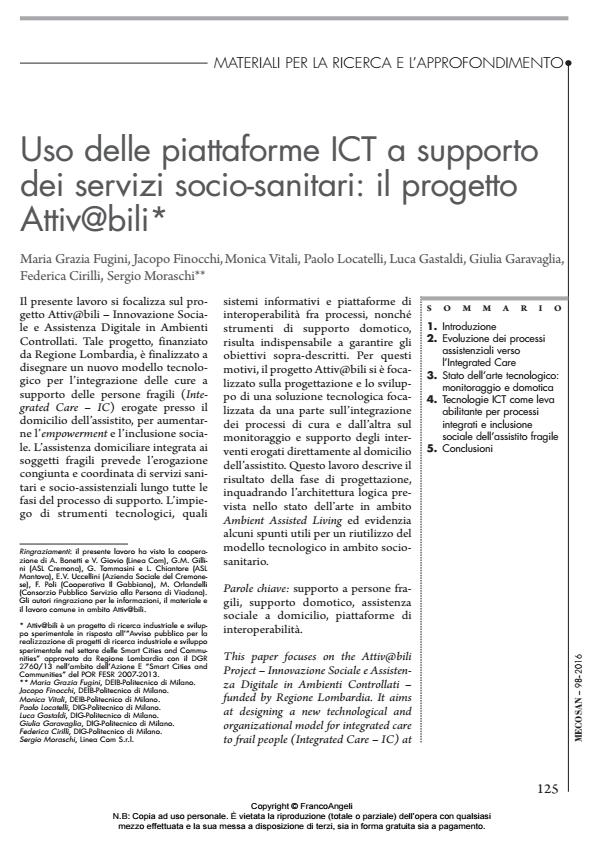Uso delle piattaforme ICT a supporto dei servizi socio-sanitari: il progetto Attiv@bili
Titolo Rivista MECOSAN
Autori/Curatori Maria Grazia Fugini, Jacopo Finocchi, Monica Vitali, Paolo Locatelli, Luca Gastaldi, Giulia Garavaglia, Federica Citilli, Sergio Moraschi
Anno di pubblicazione 2016 Fascicolo 2016/98
Lingua Italiano Numero pagine 16 P. 125-140 Dimensione file 23738 KB
DOI 10.3280/MESA2016-098007
Il DOI è il codice a barre della proprietà intellettuale: per saperne di più
clicca qui
Qui sotto puoi vedere in anteprima la prima pagina di questo articolo.
Se questo articolo ti interessa, lo puoi acquistare (e scaricare in formato pdf) seguendo le facili indicazioni per acquistare il download credit. Acquista Download Credits per scaricare questo Articolo in formato PDF

FrancoAngeli è membro della Publishers International Linking Association, Inc (PILA)associazione indipendente e non profit per facilitare (attraverso i servizi tecnologici implementati da CrossRef.org) l’accesso degli studiosi ai contenuti digitali nelle pubblicazioni professionali e scientifiche
Il presente lavoro si focalizza sul progetto Attiv@bili - Innovazione Sociale e Assistenza Digitale in Ambienti Controllati. Tale progetto, finanziato da Regione Lombardia, è finalizzato a disegnare un nuovo modello tecnologico per l’integrazione delle cure a supporto delle persone fragili (Integrated Care - IC) erogate presso il domicilio dell’assistito, per aumentarne l’empowerment e l’inclusione sociale. L’assistenza domiciliare integrata ai soggetti fragili prevede l’erogazione congiunta e coordinata di servizi sanitari e socio-assistenziali lungo tutte le fasi del processo di supporto. L’impiego di strumenti tecnologici, quali sistemi informativi e piattaforme di interoperabilità fra processi, nonché strumenti di supporto domotico, risulta indispensabile a garantire gli obiettivi sopra-descritti. Per questi motivi, il progetto Attiv@bili si è focalizzato sulla progettazione e lo sviluppo di una soluzione tecnologica focalizzata da una parte sull’integrazione dei processi di cura e dall’altra sul monitoraggio e supporto degli interventi erogati direttamente al domicilio dell’assistito. Questo lavoro descrive il risultato della fase di progettazione, inquadrando l’architettura logica prevista nello stato dell’arte in ambito Ambient Assisted Living ed evidenzia alcuni spunti utili per un riutilizzo del modello tecnologico in ambito sociosanitario.
Parole chiave:Supporto a persone fragili, supporto domotico, assistenza sociale a domicilio, piattaforme di interoperabilità
Maria Grazia Fugini, Jacopo Finocchi, Monica Vitali, Paolo Locatelli, Luca Gastaldi, Giulia Garavaglia, Federica Citilli, Sergio Moraschi, Uso delle piattaforme ICT a supporto dei servizi socio-sanitari: il progetto Attiv@bili in "MECOSAN" 98/2016, pp 125-140, DOI: 10.3280/MESA2016-098007